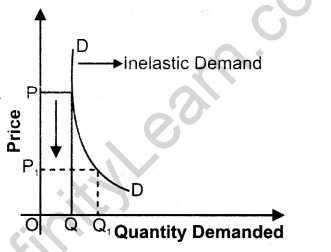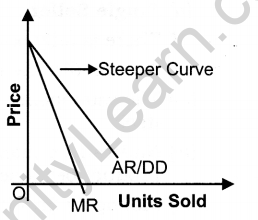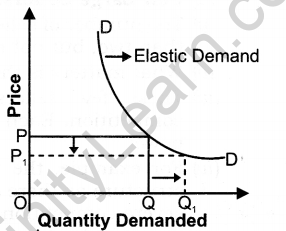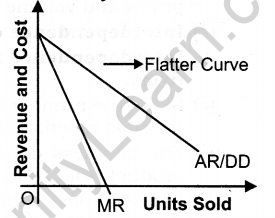Non-Competitive Market – CBSE Notes for Class 12 Micro Economics
Introduction
This chapter explains non competitive market forms (monopoly, monopolistic competition and oligopoly), their features and differences.
Monopoly
1. Meaning:
(a) ‘Mono’ means single and ‘poly’ means seller, i.e., single seller.
(b) Monopoly is a market situation where there is a single firm selling the commodity and there is no close substitute of the commodity sold by the monopolist.
2. Reasons of Monopoly:
(a) Grant of patent rights
(i) When a company introduces a new product or new technology it applies to the government to grant it patent certificate by which it gets exclusive rights to produce new product or use new technology.
(ii) Patent rights prevent others to produce the same product or use the same technology without obtaining license from the concerned company. Patent rights are granted by the government for a certain number of years.
(iii) For example, Patent certificate was granted to Xerox company for copying machines invented by it, thereby giving rights to monopoly.
(b) Licensing by Government
(i) A monopoly market emerges when government gives a firm license, i.e. exclusive legal rights to produce a given product or service in a particular area or region.
(ii) For example Previously Delhi Vidyut Board (Govt. Board) had the exclusive right to distribute electricity in Delhi. Now after privatization the same rights have been given to two private companies with exclusive areas to serve.
(c) Forming a Cartel
(i) A Cartel is a group of firms which jointly set output and prices so as to exercise monopoly power.
(ii) For example, In 1960, some oil producing companies formed a cartel, called OPEC (Organisation of Petroleum Exporting Countries).
3. Features of Monopoly:
(a) Single Seller
(i) There is only one seller or producer of a commodity in the market.
(ii) As a result, the monopoly firm has full control over the supply of the commodity.
(iii) The monopolist may be an individual, a firm, a group of firms or a government itself.
(iv) Naturally, a monopoly firm can exploit buyers by charging almost any price for its product because of exclusive control over the product.
(v) Monopoly firm itself is the price maker and not the price taker.
(b) Absence of close substitutes of product
(i) The product sold by the monopolist has no close substitute.
(ii) Though, some substitutes of the product may be available, yet they are not close substitutes in the sense that such substitutes are not identical products.
(c) Difficult entry of a new firm
(i) The monopolist controls the situation in such a way that it becomes very difficult for a new firm to enter the monopoly market and compete with the monopolist by producing the same product.
(ii) The monopolist tries his utmost to block entry of a new firm.
(d) Price Discrimination
Price discrimination refers to the practice of charging different prices from different buyers at the same time for the same product.
(e) Price Maker
(i) A monopoly firm has market power and is itself a price-maker. It can choose any price, it likes.
(ii) Unlike perfect competition where as output increases, price remains unchanged.
(iii) In monopoly as output increases or decreases, price changes according to what consumers are willing to pay along the demand curve. It produces and supplies a product to satisfy the entire market.
(iv) It is because a monopoly firm faces the entire demand of the market, that market demand curve is said to be a constraint facing a monopoly firm.
4. Shape of demand curve under monopoly:
(a) As we know in monopoly there is a single seller or firm, that is why like an industry, single seller constitutes the entire market for the product, which has no close substitutes.
(b) So, a monopolist has full freedom and power to fix price for the product.

(c) However, demand of the product is not in the control of monopoly firm. In order to increase the output to be sold, monopolist will have to reduce the price because of price discrimination.
(d) Therefore, a monopoly firm faces a downward sloping demand curve.
(e) The elasticity of demand curve is inelastic because of no close substitute of a commodity.
5. Shape of Average revenue and marginal revenue curve under monopoly
(a) A monopoly firm faces a downward sloping demand curve as more output can be sold only by reducing the price because of price discrimination.

(b) As, we know, Price = Average revenue. So, when price falls means Average revenue falls and when Average revenue fall, then marginal revenue also falls but at a much faster rate. So, Marginal Revenue(MR) is less than Average Revenue (AR).
Monopolistic Competition
1. Meaning:
(a) It refers to a market situation in which there are many firms which sell closely related but differentiated products.
(b) Market for such products are toothpaste, soap, air conditioners etc.
(c) The market is called monopolistic competition since it contains both the competitive element and monopoly element.
2. Features of monopolistic competition
(a) A large number of firms:
(i) The number of firms selling similar product is fairly large, but not very large as in perfect competition.
(ii) As a result, firms are in a position to influence the price of their product due to their branji names.
(b) Product differentiation:
(i) In this type of market situation a producer can produce different products, but that products should be a close substitute to each other.
(ii) Product differentiation means differentiating the product on the basis of brand, colour, shape etc.
(iii) Due to product differentiation each firm under monopolistic competition is in a position to exercise some degree of monopoly (inspite of large number of sellers) because buyers are willing to pay different prices for the same product produced by different firms.
(iv) No doubt, producer has a control over a price, but he knows it very well to maximize the profit price has to be reduced. So, price falls under monopolistic competition due to product differentiation.
(c) Selling cost:
(i) It is the expenses which are incurred for promoting sales or inducing customers to buy a good of a particular brand.
(ii) This includes the cost of advertisement through newspaper, television and radio, and cost on each other sales promotional activities.
Note:
Persuasive Advertising: It refers to advertising so as to lure (attract) consumers avail
from one brand to another.
(d) Free entry and exit of firms:
(i) New firms can enter the market, if found profitable. Similarly, inefficient firms already operating in the market are free to quit the market if they incur losses.
(ii) It is because of this feature that like perfect competition, monopolistic competition also gives rise to normal profit.
(iii) No firm receives abnormal profit in the long run as then new firms can emerge and old ones can expand output and adjust supply with changing demand.
3. Shape of Demand Curve Under Monopolistic Competition
(a) The demand curve faced by a firm is negatively slope, (i.e. when price falls, demand rises) because the firm can sell more only by lowering the price of its product because of product differentiation.

(b) The demand curve in monopolistic competition is highly elastic due to availability of close substitutes as a result, AR curve becomes more flatter.
4. Shape of Average revenue and marginal revenue curve under Monopolistic Competition:
(a) Like a monopoly firm, the firm under monopolistic competition also fixed the price itself subject to certain limitations.

(b) No doubt, producer has a control over a price, but he knows it very well to maximize the profit, price has to be reduced. Price reduce means Average Revenue reduces and average revenue reduces marginal revenue but at a much faster rate. So, under monopolistic competition MR < AR.
Oligopoly
1. Meaning:
(a) The term oligopoly is derived from two Greek words: ‘oligoi’ means few and ‘poleein’ means ‘to sell.’
(b) Oligopoly is a market situation in which an industry has only a few firms (or few large firms producing most of its output) mutually dependent for taking decisions about price and output.
(c) William Fellner defines oligopoly as “Competition among the few”.
(d) In India, markets for carbonated beverages, “National Newspapers” market, mobile services provider, washing products, automobiles, cement, aluminium, etc., are the examples of oligopolistic market. In all these markets there are few firms for each particular product.
2. Types of Oligopoly:
(a) Pure or Perfect Oligopoly:
(i) In the case of pure oligopoly, firms produce homogenous products like copper, iron, steel and aluminium.
(ii) So, decisions by consumers to purchase the goods of a particular firm are influenced by the price considerations.
(b) Imperfect or Impure or Differentiated Oligopoly:
(i) In differentiated oligopoly, firms produce differentiated products such as toilet soap, cigarettes or soft drinks.
(ii) The goods produced by different firms have their own distinguishing characteristics, but they are close substitutes of each other.
(c) Collusive Oligopoly: If the firms cooperate with each other in determining price or output or both, it is called collusive oligopoly or cooperative oligopoly.
(d) Non-collusive Oligopoly: If firms in an oligopoly market compete with each other, it is called a non-collusive or non-cooperative oligopoly.
3. Features of Oligopoly
(a) Few Large Sellers:
(i) The number of sellers in an oligopoly market is small – when there are two or more than two, but not many sellers.
(ii) What matters is that these few sellers account for most of the industry’s sales.
(iii) These “few” sellers consciously dominate the industry and indulge in intense competition. Each firm is aware of that it possesses a large degree of monopoly power.
(iv) For example, the market for mobile service provider in India is an oligopolist structure as there are only few producers of mobile service provider. There exists severe competition among different firms and each firm tries to manipulate both prices and volume of production to outsmart each other.
(b) Interdependence of Decisions:
(i) Interdependence means that actions of one firm affects the actions of other firms.
(ii) Since the number of sellers is small, each firm has to take into consideration the possible reaction of its competitors, when making decisions.
(iii) The business decision of a single seller will have a substantial impact on the product price, output and profits of the rival firms.
(iv) For example in the “National Newspapers” market, when the “Economic Times” introduced invitation pricing policy—they offered the newspaper at a price of Rs.1.50 on weekdays. The Hindustan Times was forced to reduce its prices from Rs. 2.50 per copy to ? 1.50 per copy on weekdays. When Hindustan Times was celebrating its 75 years of service, they offered the newspaper at Rs. 1/- weekdays. The Times of India responded by matching the price cut.
(c) Non-Price Competition:
(i) Oligopoly firms try to avoid price competition for the fear of price war.
(ii) They use non-price competition methods like better services to customers, advertising, etc. to compete with each other.
(iii) Oligopoly firms are in a position to influence the prices. However, they follow the policy of price stability or price rigidity.
(iv) Price rigidity refers to a situation in which whether there is change in demand and supply the price tends to stay fixed.
(v) If a firm tries to reduce the price the rivals will also react by reducing their prices. Likewise, if it tries to raise the price, other firms will not do so. It will lead to loss of customers for the firm which intended to raise the price.
(vi) So, firms prefer non-price competition instead of price competition.
(d) Barriers to the entry of firms:
(i) The main reason why the number of firms is small is that there are barriers which prevent entry of firms into industry.
(ii) Patents, large capital, control over the crucial raw material etc., prevent new firms from entering into industry.
(iii) Only those who are able to cross these barriers are able to enter.
(e) Role of selling costs:
(i) Due to severe competition and interdependence of the firms various sales promotion techniques are used.
(ii) For example, T.V. commercials war between pepsi and coke.
(iii) It relies more on non-price competition.
(f) Oligopoly firms may produce either a homogeneous or a differentiated product.
(i) Oligopoly firms may sell homogeneous products such as steel, aluminium, LPG cylinders etc. They are called pure oligopolies, as the products of the respective firms are indistinguishable.
(ii) Firms producing differentiated products are called impure oligopolies.
(iii) In case of a pure oligopoly market situation rival firms will rely on “price” or “lowercosts” to compete in the market.
(iv) On the other hand, in case of impure oligopolies, with firms producing differentiated products, firms can use “product variations” and “promotional” strategies to compete.
(g) Group Behaviour:
(i) In an oligopoly situation, there are a few firms who control the entire market and each firm recognizes interdependence in their decision-making.
(ii) So, price-output decisions of a particular firm directly influence the competing firms.
(iii) Instead of independent price and output strategy, oligopoly firms prefer group decisions that will protect the interest of all the firms.
(iv) Group Behaviour means that firms tend to behave as if they were a single firm even though individually they retain their independence.
(h) Indeterminate demand curve facing an oligopoly firm:
(i) The most distinguishing feature of oligopoly is the “interdependence in decision making” of the rival firms.
(ii) The consequence of such interdependence is the high degree of uncertainty regarding the reaction pattern of rival oligopolists.
(iii) Interdependence and uncertainly result in “indeterminateness of the demand curve” facing an oligopolist. The firm cannot assume that his rivals will not react to its decision regarding change in its variables.
(iv) The demand curve facing an oligopoly firm keeps shifting as rival firms react to changes made by this firm. The demand curve thus loses its definiteness and determinateness.
Words that Matter
1. Monopoly: It is a market situation where there is a single firm selling the commodity and there is no close substitute of the commodity sold by the monopolist.
2. Cartel: A Cartel is a group of firms which jointly set output and prices so as to exercise monopoly power.
3. Monopolistic competition: It refers to a market situation in which there are many firms which sell closely related but differentiated products.
4. Product differentiation: It means differentiating the product on the basis of brand, colour, shape etc.
5. Selling cost: It is the expenses which are incurred for promoting sales or inducing customers to buy a good of a particular brand.
6. Persuasive Advertising: It refers to advertising so as to lure consumers avail from
one brand to another.
7. Oligopoly: It is a market situation in which an industry has only a few firms (or few large firms producing most of its output) mutually dependent for taking decisions about price and output.
8. Pure or Perfect Oligopoly: In the case of pure oligopoly, firms produce homogenous products like copper, iron, steel and aluminium.
9. Imperfect or Differentiated Oligopoly: In differentiated oligopoly, firms produce differentiated products such as toilet soap, cigarettes or soft drinks.
10. Collusive Oligopoly: If the firms cooperate with each other in determining price or output or both, it is called collusive oligopoly or cooperative oligopoly.
(i) The MR and MC schedules
(ii) The quantities for which the MR and MC are equal
(iii) The equilibrium quantity of output and the equilibrium price of the commodity.
(iv) The total revenue, total cost and total profit in equilibrium.
11. Non-collusive Oligopoly: If firms in an oligopoly market compete with each other, it is called a non-collusive or non-cooperative oligopoly.
12. Price rigidity: It refers to a situation in which whether there is change in demand and supply the price tends to stay fixed.

